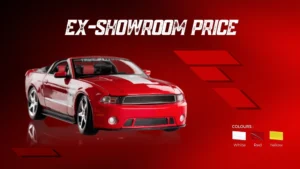When planning to buy a car or a bike, you will often come across two terms: EX-Showroom vs. On-Road Price. Although they both have to do with the price of the car, they each represent a distinct part of the actual cost. Understanding the distinction between these two is quite essential if you want to properly manage your budget and steer clear of any unpleasant surprises.
Let’s break down the differences between these prices and why they matter.
What is the Ex-Showroom Price?

The price that is quoted by the manufacturer and made available at the dealership is known as the Ex-Showroom Price.
- Manufacturing Costs: The basic cost of producing the vehicle.
- GST (Goods and Services Tax): This tax is applied to the price of the vehicle.
However, it does not include major charges like registration, insurance, and road taxes. It gives an estimated idea of what one would incur at a dealership for a vehicle; you can’t drive off the lot in a vehicle at that price.
What is the On-Road Price?

The On-Road Price is actually what one finally pays to take the vehicle home and legally drive it on public roads. This price is inclusive of the ex-showroom price, along with various other charges that were needed to complete the ownership process.
Typically, the on-road price of a vehicle would cover:
-
- Registration Charges: A sum paid to the RTO in exchange for the vehicle’s registration.
-
- Road Tax: The state government charges this tax. These vary depending on the location of registration and type of vehicle.
-
- Insurance: Quite a general mandatory spend to cover accidents, damages, third-party liability, amongst others.
-
- Handling Fees: The selling dealer’s commission for handling the vehicle’s delivery, documentation, and other procedures.
-
- Optional Add-ons: Accessories, extended warranties, and other services that the dealer might offer are examples of optional add-ons.
While the ex-showroom price gives one a pretty fair idea of what it costs at its base, it is highly misleading in that it does not take into consideration some major expenses. On-road price covers the total expense one needs to incur to make the vehicle road-legal so that you will be better equipped to afford the actual running cost of such a vehicle.
Factors Affecting On-Road Price
-
- Location: The tax rates of road tax may differ from state to state. Thus, the on-road price of the same vehicle would vary based on your geographical location.
-
- Insurance Options: The total cost will increase if you choose a comprehensive insurance policy over a basic third-party policy.
-
- Accessories: Clearly, the onboard price will soar if you add customized wheels, high-performance audio, or any added feature such as an extended warranty.
-
- Type of Vehicle: Luxury cars and cars with larger engines are subject to higher registration and tax rates, which drives up the total cost of the vehicle.
Conclusion
First, there is a huge difference between the EX-Showroom vs. On-Road Price when purchasing a car. The on-road price will be a real cause for concern, even though the ex-showroom price provides an approximate value. This price represents the entire cost, including all applicable taxes, registration fees, and insurance for proof of legal ownership.
You will have a rough notion of the total amount of expenses you will incur if you focus more on the cost of the route. Always request a detailed quote from your dealer regarding the on-road price to avoid any last-minute surprises and to ensure a smooth and informed car purchase.
Also Read: The Electric Vehicle Revolution






Leave a Reply